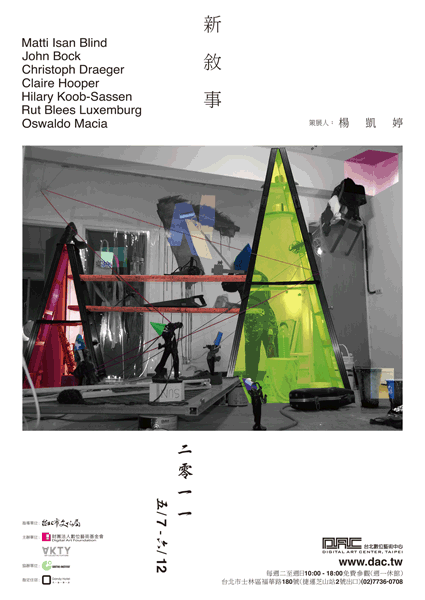《新敘事》New Narrative
ꕥ 展期 Duration:2011/05/07 (六) – 2011/06/12 (日)
ꕥ 開幕 Opening:2011/05/07 (六) 14:00
ꕥ 地點 Venue:台北數位藝術中心
ꕥ 地址 Address:111台北市士林區福華路180號;近捷運淡水線芝山捷運站二號出口
ꕥ 展覽介紹
策展人Curator / 楊凱婷 Ada Kai-Ting Yang
「新敘事 New Narrative」展覽,帶來目前最新活躍於歐美藝壇的藝術家作品。各作品在世界各地發表,包括:倫敦、柏林、紐約、法蘭克福等。盼能透過台北數位藝術中心讓更多的國外藝術家與台灣藝壇作學術交流。自古以來,文學、戲劇、詩歌、圖畫相互紀錄人類的故事,使後人得以了解歷史文化的傳承與延續。新的電腦科技促成媒體整合,策展人想提出的一個論點是:科技藝術不單單是用技術來開發視覺創作的所有可能性,觀者必須了解從作品的中心思想核心來剖析,其實他們真正要強調的是想法、隱藏在影像或節奏下人類所面臨的各種問題,她想做的是一個反應時代性的展覽。
媒體理論家麥克魯漢(Marshall McLuhan)認為未來全球性交流(Global Communication),不須要單一的理論規範,而是以能不斷重新編組的解謎方式生存下去。這樣的生活方式無一定的法則,要在各種不同的關係之中思考、創造各種可能的生存方式。策展人企圖實踐國際前衛運動(International Avant-garde),定期地邀請外國藝術家來臺灣參展、創作、演講、教學、公開表演活動等。化行動為力量,把歐洲與亞洲的藝術線連起來,實踐麥克魯漢所稱的全球化交流。
故,「 新敘事 New Narrative」 展覽企圖讓觀眾看到數位藝術的全體,包括:約翰博客,在博客式表演性下,對德國表現主義的重新詮釋; 馬西亞把超音波聲音視覺化的過程; 霍普,把對現代建築柏林地下鐵的研習,創造出這高速剪輯的 20 分鐘影片,拼湊合成建築、設計、希臘神話拼貼; 椎格的再製作(Remake)影片美學。
最新且正在發生變化的電子數位藝術的動向,已漸漸走出機械化、虛擬實境 (Virtual Reality)的主題內容 ; 相反的,利用最新的科技技術,以歷史悠久的哲學或美學理論作為創作的根基,甚或寫出對當今社會結構、經濟現象的詩句,試著改變社會普羅大眾對藝術的觀感。同時,在數位影像區內,以巨型攝影裝置多元化呈現「科技如何改變我們觀看影像?」
盼新敘事為表演性(performance)勾勒出抽象的語言。
策展人簡介 Curator
楊凱婷,出生於台北。她畢業於倫敦藝術學院的卻爾喜分院。
2009年,她拿到三個月的補助金,搬到福岡,於福岡亞洲藝術美術館擔任「第四屆福岡亞洲藝術三年展-共生:明日的創造者」的特別進修人員。
她所策劃的展覽作品曾多次在歐洲與海外展出。最近的展覽包括在伊通公園的時光機與任意門,與台北數位藝術中心的新敘事展覽。
她的概念性計劃案多元取件,包括:錄像、裝置、雕塑、素描與攝影。她強調介於台灣與歐洲的當代學術文化交流。她也對創意社群的合作想法感到興趣。故,為一藝術合作平台 AKTY 的發起人,旨為跨領域的合作想法實踐。
楊凱婷目前在倫敦及台北居住及工作。
Ada Kai-Ting Yang, born 1982 in Taipei. She studied at Chelsea College of Art & Design, University of the Arts London.
In 2009, she moved to Fukuoka on a three months-internships to the 4th Fukuoka Asian Art Triennale- Live and Let Live: Creators of Tomorrow at Fukuoka Asian Art Museum.
She has curated shows in Europe and Asia. Including the most recent shows at IT Park Taipei- Time Machine & Anywhere Door and Digital Art Center Taipei – New Narrative.
Yang is a curator whose conceptual projects take form in video, installation, sculpture, drawing and photography with emphasis on contemporary cultural exchanges between Taiwan and Europe. Yang is also interested in ideas of collaboration within the creative community. Thus she is the founder of AKTY, art collective platform.
She lives and works in London and Taipei.
ꕥ 關於藝術家
西拉瑞.古柏薩森
1975 年出生於紐約 ; 居住、工作於倫敦
藉著文字、歌曲、雕塑、影片和表演,古柏薩森拓展並主導了以科學和政治為訴求之過程主義景觀藝術。他近期著手的作品:「對基礎建設之信賴」,將時代中的生活和建設貫穿於一個四體模型。很這典型的,「對基礎建設之信賴」以宣言、圖表、六座雕塑,合組成此一高畫質高清影片的同步播放形態來呈現。
其中的歌曲以及幾項不同的演出是和大提琴家-錯誤主義者安德烈亞斯科勒共同合作。(www. TheErrorists.com) 。
目前他正著手進行一部長篇電影《Transcalar Investment Vehicles》(Transcalar投資工具), 並因此獲得了倫敦弗萊明製片的電影輔導金。
在維星藝術中心的研究中心駐村後,今年夏天他將會創作一系列的大理石、鋼材和菩提木的大型雕塑作品。
Hilary Koob-Sassen
1975 New York. London-based
With text, song, sculpture, film and performance Hilary Koob-Sassen names, models, inhabits and discusses processual landscapes of scientific and political proposals. His recent project Faith In Infrastructure traverses a four-dimensional model of the living and the built in time. Typically, Faith In Infrastructure took form as a manifesto, six sculptures, and an architecturescale video. Its 6 songs and several of a variety of performances were made in collaboration with the cellist Andreas Köhler as The Errorists. (www.TheErrorists.com) Koob-Sassen is a visiting lecturer and critic to graduate students in the fields of art, architecture and performance.
﹉﹉﹉
奧斯瓦多.馬西亞
1960年09月11日出生於哥倫比亞卡塔赫那。目前居住在英國倫敦。
在我的作品中,我希望探討關於知識與感知的假設。基本上,我們對於這個世界的認知,是透過傳統和期望形塑而成的,而這種理解,經常迫使我們壓抑對周遭事物的直接感受。然而,對於外在世界給予我們的刺激,我們經常利用影像與資訊來表達,而這種訊息的處理,與感官與思考我們認為我們了解的世界有關。
我希望我的作品,能夠將感知的靜態視覺,轉化為感官的知覺型態,有聲音、氣味和影像,而這樣的過程,打破了我們以往建構世界的假設,去除單一客觀的錯置知識信念。我的作品包含了影像、實物、聲音與氣味,不論是那一項要素,都具有雕像般的空間實體,讓周圍的事物因它們而動。雕刻主要探討人類與形成我們這個世界的物體有關,而拓展作品中的感知範疇,讓我的作品由主觀邁向客觀,從經驗造就了知識。
透過聲音的雕塑、氣味的雕塑、影像與裝置,我希望我的作品能反映出人類與他們認為的現實之間的多重關聯性,顛覆我們以為的那個世界,提供觀賞者反動的思想,讓他們看得更仔細、聽得更真切、更注意嗅覺,更深入去思考我們賴以建構知識的世界。
展示於:
泰德利物浦雙年展,第51屆威尼斯雙年展,上海雙年展,第八屆哈瓦那雙年展,西班牙馬德里的蘇菲雅美術館,白教堂藝廊,瑪麗安‧古德曼巴黎藝廊,南倫敦畫廊等等。
In my work I seek to question assumptions about knowledge and perception. The ways in
which we attempt to understand our place in the world is structured through conventions
and expectations that often overwhelm our own direct perception of what surrounds us. I
am particularly concerned with how the external stimuli we receive from the world is
translated into images and information through our senses, mediated by what-we-thinkwe-
know.
I strive in my work to make a move from an ocularcentric mode of perception, claiming
sound, smell and vision in an expanded sensorial mode of perception. Such a process
breaks the assumptions we use to structure the world, undoing a misplaced belief in
singular and objective knowledge. My compositions are formed from images, objects,
sounds and smell. Whether object, video or image, the works operate as sculptures in that
they occupy space, pulling and pushing all that surrounds them for their own ends.
Sculpture is concerned with the relationships people have to the objects that form the
world we experience; in utilising a wider perceptual range my work opens itself to
subjectivity over objectivity, experience over knowledge.
Throughout my sound-sculptures, smell-sculptures, videos and installations I aim to
create encounters that initiate and reflect upon multiple relationships with what-isbelieved-
to-be-reality. My artistic practice sets out to complicate what-we-think-we-know
by offering counter-perceptions in proposals to look harder, listen more acutely and pay
attention to the sense of smell in order to think deeper about the structures of knowledge
we rely on to construct that which is taken for knowledge.
﹉﹉﹉
克萊兒.霍普
克來兒.霍普,1978年出生於倫敦,作品深獲國際肯定,包括:歐洲與世界各地。即將展覽的聯展、個展有:慕尼黑羅亭爾畫廊、維也納MUMOK 現代美術館、倫敦速寫藝廊、台北伊通公園、柏林KW當代美術館,以及許多由倫敦蛇紋石藝廊和白教堂藝廊所策劃組織的活動。
她的作品代理藝廊為倫敦Hollybush 花園藝廊。2010 年瑞士巴賽爾藝術博覽會,霍普贏得宣言競選區裡的 Baloise 藝術大獎。
Claire Hooper
Claire Hooper, born 1978 London, has shown widely in Europe and abroad Including recent and forthcoming shows at Lothringer 13, Munich; MUMOK, Vienna; Sketch, London; IT Park Taipei;Kunstwerke, Berlin; and at various events organised by the Serpentine and Whitechapel galleries in London.
She is represented by Hollybush Gardens London and was the 2010 winner of the Baloise Art Prize at Statements, Art Basel.
﹉﹉﹉
克里斯多夫.椎格
克里斯多夫.椎格 出生於蘇黎世,在靠近達渥斯的瑞士山間長大。曾在布魯塞爾就讀比利時國立剛勃高級視覺藝術學院和於瑞士琉森的視覺藝術學院。1996年他拿到一年的獎學金,搬到紐約,於長島市當代藝術機構的P.S 1研讀國際攝影課程。自此,他再也沒有離開過紐約。
椎格是國際級藝術家,他的概念投射於裝置藝術、畫畫、雕塑、錄像以及影像為主的媒體,以探索災難相關的問題以及媒體氣息濃厚的文化。他的作品在全世界的藝廊和藝文機構裡展出,包括: 巴西聖保羅的公共當代美術館、德國柏林現代藝術中心、南韓的光州雙年展、法國巴黎的龐畢度中心、瑞士蘇黎世美術館、俄羅斯莫斯科雙年展、英國倫敦的統一畫廊(Union Gallery)、英國利物浦雙年展、北愛爾蘭德里的蘭花畫廊(Orchard Gallery)、西班牙馬德里的藝術博物館Alcala 31、墨西哥市卡里諾吉爾當代藝術博物館,還有紐約的布魯克林博物館、惠特尼美國藝術博物館與羅伯零藝術畫廊。
他的作品被各地機構收藏,包括: 惠特尼美國藝術博物館、紐約布魯克林美術館、瑞士蘇黎世美術館及法國巴黎的龐畢度中心。
最新的電影:嬉皮電影(五十三分鐘長,2008年)於2010年二月在紐約現代藝術美術館中展示。
克里斯多夫.椎格目前在紐約及維也納居住及工作。
Christoph Draeger
Born in Zurich and raised in the Swiss mountains near Davos, Christoph Draeger studied at Ecole Superieure des Art visuels de la Cambre, Brussels and School of Visual Arts, Lucerne, Switzerland. In 1996, he moved to New York on a one year-scholarship to the International Studio Program at P.S 1, Institute for Contemporary Art, Long Island City. He never left New York again.
Draeger is an international artist whose conceptual projects take form in installation, drawing, sculpture, video, and photo-based media to explore issues pertaining to disaster and media saturated culture. His work has been exhibited with galleries and institutions world-wide: Paco das Artes in Sao Paulo/Brazil, Kunstwerke in Berlin/Germany, Kwangju Biennial, South Korea, Centre Pompidou in Paris/ France, Kunsthaus Zurich/Switzerland, Moscow Biennial/Russia, Union Gallery in London/UK, the Liverpool Biennial/UK, Orchard Gallery in Derry (Northern Ireland), Alcala 31 in Madrid/Spain, Carillo Gil Museum in Mexico City among others; as well as at the Brooklyn Museum, the Whitney Museum and Roebling Hall in New York. Draeger’s work is in the collections of the Whitney Museum of American Art, New York, the Brooklyn Museum, New York; Kunsthaus Zurich, Switzerland; and Centre Pompidou, Paris, France. His latest film, Hippie Movie (53 min, 2008), was shown at MoMA Museum of Modern Art in New York in February 2010.
He lives and works in New York and Vienna.
﹉﹉﹉
約翰.博客
1965年出生於德國 Gribbohm。目前工作、居住於柏林。
John Bock
Geboren / Born 1965 in Gribbohm
Lebt und arbeitet / Lives and works in Berlin
﹉﹉﹉
盧.布莉絲.盧森堡
德國女攝影師盧‧布莉絲‧盧森堡是一名藝術家,大多數的攝影作品都與城市的公共空間有關。作品中營造出一種沈浸而多變的風格,挑戰既定都市詭詐的感知。她在不同的城市間旅行,其攝影巧妙地編織出一種嚴密的空間與張力,提供觀賞者文藝與哲學的思想空間。
她一直致力於發掘攝影在公共與探索層面的表現,從她早期以倫敦為背景的公共攝影裝置—塔利班之塔,以及由她協助指導在ICA演出的歌劇—愛之歌/我的自殺事件,還有她近期在希斯洛機場的攝影裝置藝術—皮卡迪利街的瑕疵,可見一斑。
盧‧布莉絲‧盧森堡的攝影作品,廣受全球的肯定,近期曾在巴黎的龐畢度、倫敦的皇家學院與西班牙的拉波拉藝術中心展出,此外,許多知名的美術館,如倫敦著名的泰特現代美術館、維多利亞&艾伯特博物館、法國國立視覺藝術中心等,皆收藏了這位名藝術家的作品。
Rut Blees Luxemburg
Rut Blees Luxemburg is an artist whose large-scale photographic work shows the public spaces of the city. She creates immersive and vertiginous compositions that confront established perceptions of the urban artifice. Shot in different cities, her work is woven from literary and philosophical references which constitute a rigorous frame of thought and make the tension in her photographs possible.
Rut Blees Luxemburg has been continuously investigating the potential of photography in a public and exploratory context, from her early London-based public photo-installation Caliban Towers through to her collaborative opera Liebeslied/My Suicides which was staged at the ICA, London and her more recent photographic installation at Heathrow Piccadilly’s Peccadilloes.
Her photographs have been exhibited internationally, recently at the Pompidou Centre, Paris, the Royal Academy, London and LaBoral, Spain. Many public collections such as the Tate Modern, Victoria & Albert Museum and CNAP have works of the artist.
﹉﹉﹉
馬地伊山.布藍德
在他的作品裡探索真實與符號的領域,創造一個詮釋、描繪和轉變的集中處。他的作品融合畫、照片、物品以及各個不同的反應,不管是對白立方空間論述、融合的建築想法、形狀和表面、設計、音樂、大眾文化和他當下周遭的反應。於2009年的一個展覽裡在天花板上弄了裂縫,讓光從裂縫透出,透出的光就是展示房間和房裡物品裡唯一的光線來源。他對虛像很有興趣,鏡子所反射出的矛盾和象徵性的因素,代表了欺騙和真實,幻想的空間與無形的現實。或許他2010年的作品「盲點」就是好例子,作品中有一串鑰匙偶然掉到一疊雜誌和紙張上,看出他渴望用大家可以立刻辨識出的東西,然後同時用老掉牙的「神奇」、好玩和平凡的方式轉變物品,侵蝕並且堆積我們所熟悉的情況、物件、符號、音樂、意象和結構。
Matti Isan Blind
Initially my work comes from this very straightforward idea of art. What my concept of art is, is at its core just this elemental feeling, this very elemental, almost child-like expression. I like simplicity. Simple things often have a more straight forward voice, you can see it and you get it, but when you take an extra step and you enter the world I make, then it could be more tricky. I have always been an artist who tries to walk around with open eyes and an open mind and I try to show what we call pop culture, inspired by its various sources in music, videos, architecture, my immediate surroundings and the way people dress, looking at it all and eat it and I am very excited living all this in my art.
ꕥ 作品介紹 1
對公共建設的信任 Faith In Infrastructure
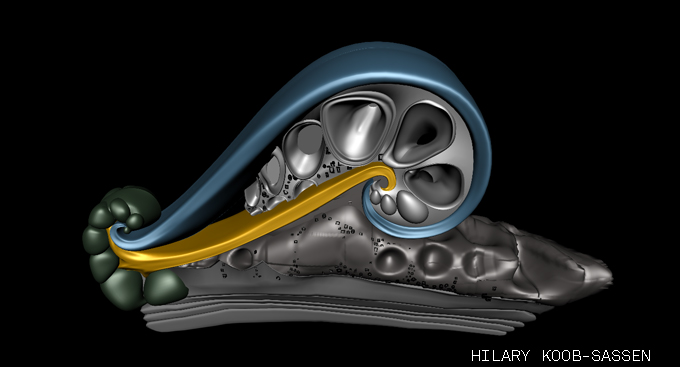
同步雙投影HD 影片,30分鐘,2009
在討論「有機經濟學101」與「如何成為橫向文化」之前,很重要的是/我要重述/我錯誤份子的憑據/你得讓自己的重要性鋒利如刀。我渴望伸頭一刀,因為我一點也不相信我自己提議的,儘管我一心一意。
因為—提議對文化而言就如同變遷之於生物:常常很枯燥、鮮少有害而且這是我們現在跟未來所需要的:美麗且彎彎的口器吸取花朵的花蜜 ,更容易吸取。
所以,我們如何變得具有「橫向文化」?
我們如何接收生活的軌道,而且有意識地當作為自己的?
我提議一個出口,離開生物學拉丁彌撒。我提議這個婀娜地更新的老神生活。我們需要一個新的文字遊戲和與渾沌的直接關係。
我們不能將發展與起源搞混。說一個國家發展就是說國家發展成最終果實豐碩的結構,這只是等待經驗,經驗的基礎讓國家呈現出完美的結果。
事實上,手邊的工作是為了找出—如果有答案的話—到底什麼能當作類似去氧核糖核酸的東西,類似其排列結構和意思。
我會告訴你我的想法,幾乎是絕對錯誤的:
沒有結構,歌曲很複雜,能夠唱進世界的主體,除了標準的人類器官系統。在那個花園裡,四十億個細胞一致精神分裂地唱歌—唱單一人類意識。那套器官只是唯一一首複雜的歌曲,複雜的夠我們每個人一起唱這首歌。我們心理翻譯的多元性。放諸四海皆同的身體。
或許吧!
但是胚胎發展絕對不是演化而是非常精細的過程—演化論的產品。再說,沒有任何指引來告訴我們所站何處。再者,演化論3已結束,其時間框架是如此的緩慢,對我們一點用處都沒有。我們不是演化的代理人,而是滅種的。除了這些以外,我們還是精心製作的成品經手人。我們參與建造身旁世界的主體。那般規模的第一個主體。我們是無向量的跳躍,在錯綜複雜裡從建立第一個主體的細胞文化中跳出,但那卻是我們最近的類比。
我們必須敞開雙臂接受成為發起人得經歷亂七八糟的過程,而且將世界已然在胚胎發展的某個階段完全演化的想法通通忘記。讓我們說「國家系統是目前最初的器官,這個系統結構包含宇宙的一切。身體的器官就如同宇宙的細胞。」
我們必須對科學講求嚴謹,對詩也是。
我們必須成為虔誠且有詩意的科學家,在其他文化規模的經驗類比地圖上,表現詮釋。我們必須尋求成為像是五種文化,將其藝術推過已建立的藝術和當下的藝術之門。
人性站在其創造物的框架裡。我們唱了這首橫向文化梯,唱成實際存在的事物。從一顆苞子:從一種探索現實和承受的方式:種植、灌溉、收穫不變的結果。到一座橋:物質主義,支持擁有人性向前穿越時間,以及改變霸權的制約。而今我們來到更開放的地方,事物搖擺,開始崩裂。我們相信新一種的結構增殖:網路、市場和泡沫。泡沫就像填不飽的飢餓感。泡沫長久以來就如同大教堂般,是適當的投資工具。闡述全球經濟體的時候,我們激發了世界器官。但,我們如何將世界器官唱進結構裡呢?
喚起意思的世界器官:奔放設計民主的超核心。
用錢保銀行、防洪隄上推沙袋以及補助乙醇得視為「反擊」-試圖提出小提議來克服邪惡經驗,希望發展出對應之道。我們不能再往負載過量的肝臟裡塞糖,得開始將一些可愛的腎臟形式化—太陽海和滾動的綠色植物。我們得成為有機化經濟學家,在計畫的形式裡找出新系統,將生命的軌道推前,從經濟體到器官。
例如:網路是全球的但非全宇宙的資訊經濟。數位化的球形Google大教堂(比喻地球) 地圖馬賽克—由外翻向內。八十億的人,化身調查去尋找所有可能性的整體,我們到底往何處去?所有人類的夢,透明度地互相重疊。我們偵測得出差異,儘管多數人創造了更密集的線。我們提議的句構章魚,以及我們計畫的形式,取代了缺少的計畫和無形的手。取了畫素更高的名字。畫面更清晰,資訊更密集,啓發出行動決心。這是器官/我們未完成的網路經濟體/積極想轉變地。這過程應是自然的,但不是不能避免。
此文摘選自:對公共建設的信任—錯誤份子的宣言
發表於
時間:2008年10月18日
地點:倫敦蛇形畫廊
Faith In Infrastructure
Hilary Koob-Sassen
Synchronized two channel HD videos, 30 min, 2009
Before “Organific Economics 101” and “How to be Paracultural”, It is extremely important / for me to refresh / my errorist credential/ and for you to sharpen your criticality to an axe- murdering edge. I long for that chop, for I am in no way convinced of what I propose, tho very committed to proposing it.
For- Proposal is to culture what mutation is to creature: Often dull, rarely harmful, and every now and then it is just what we need: The fancy curved beak to suck the nectar… out of the flower…better.
So, how do we become Paracultural?
How do we take on the trajectory of life, consciously as our own?
I propose an exit from the Latin mass of biology. I propose this curvaceously updated old god Life. We need a new word game and a direct relationship with the godmaths.
We must not confuse development and origination. To say a nation develops is to imply that a highly perfected map of a final fruiting structure exists within that nation- that it merely awaits the set of experiences- a mother- which would allow it to unfurl its perfection.
In actual fact, the main work at hand is to find out what- if anything- could be astutely considered analogous to DNA- to its syntactical structure and to its meaning.
I will tell you what I think- almost definitely wrong:
No structure song is complex enough to be sung into world body, except, that standard human system of organs. In that garden 4 billion cells sing in schizophrenic unity- a single human consciousness. That system is the only song complex enough for us each to sing it together. The translational diversity of our minds. The universal sameness of our bodies.
Maybe.
But definitely and for sure embryonic development is not evolution. It is a highly refined process-product of evolution. And again, no guide to where we stand. Furthermore, evolution3 is over- its time frame is so slow that it is no use to us. We are agents of extinction, but not of evolution. Far beyond all else, we are agents of elaboration. We are practicing and building a world body around ourselves. The first body of that scale. We are a scalar leap in complexity from the cell culture that built the first body. And yet, that is our closest analogy.
We must embrace the messy process of becoming, of first origination! and forget all ideas that the world is a fully evolved thing in some stage of embryonic development.
Instead let us say, “The nation state system is like a proto-organ in so far as it is a universally inclusive structure. As the organs of a body are universal to its cells.”
We must be rigorous in our science and also in our poetry.
We must be pious and poetic scientists, performing exegesis on the analogy map of the experiences of other scales of culture. We must seek to be like the five cultures that pushed their art across the threshold between the built and the alive.
Humanity stands inside a framework of its own creation. We have sung this paracultural ladder into existence. From a spore: from a way to navigate reality and endure; planting, irrigation, harvest unchanging. To a bridge: a materialism, which supports the procession of humanity forward through time and changing hegemonic formulations. And now we have come to a more open place where things shake and start to break. We put our faith in multiplication of a new kind of structure: the web, the market and the bubbles. The bubbles, which are like an unsatisfied hunger. The bubbles, which long to be cathedrals- to be proper investment vehicles. In elaborating global economies, we evoke world organs. How do we sing them into structure?
Bailing-out banks, sandbagging levees and subsidising ethanol must be characterized as “thrashing about”- an attempt to surmount an evil experience by rampantly generating small proposals- in the hopes of developing a response. We must move from pushing sugar into over-loaded liver and set out to formalize some lovely kidneys- solar seas and roiling greens. We must be Organific Economists- seeking-out new systems in the Pattern of the Plans; advancing the trajectory onward from economies into organs.
For example, the web is a global- but not universal- economy of information. It evokes a world organ of meaning: the super-nucleus of a rampant design democracy. A spherical digital google cathedral earth map mosaic- flipped outside-in. Inside, 8 billion humans’ incarnations are surveying the entirety of what could be. The overlapped transparencies of all humanity’s dreams. So difference is detectable, tho majority creates a denser line. Our syntax octopus of proposals and our pattern of the plans replaces the lack of plan and the invisible hand. With a higher resolution name. High resolution in the sense of high informational density, and in the sense of inspiring resolve to act. That is the organ / which our unfinished web economy/ seeks to be. It is natural, but not inevitable.
The statement is partly selected from:
Faith in Infrastructure- An Erroritst Manifesto
Presented at the Serpentine Gallery
London, October 18, 2008
﹉﹉﹉
ꕥ 作品介紹 2
平衡 Equilibrium
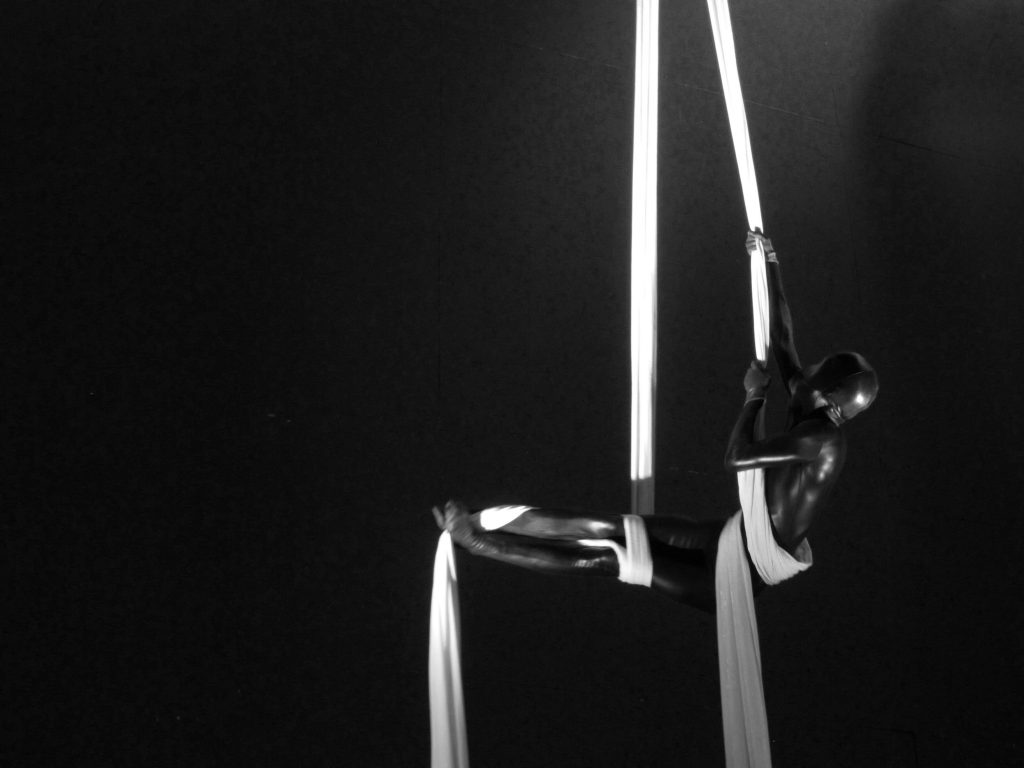
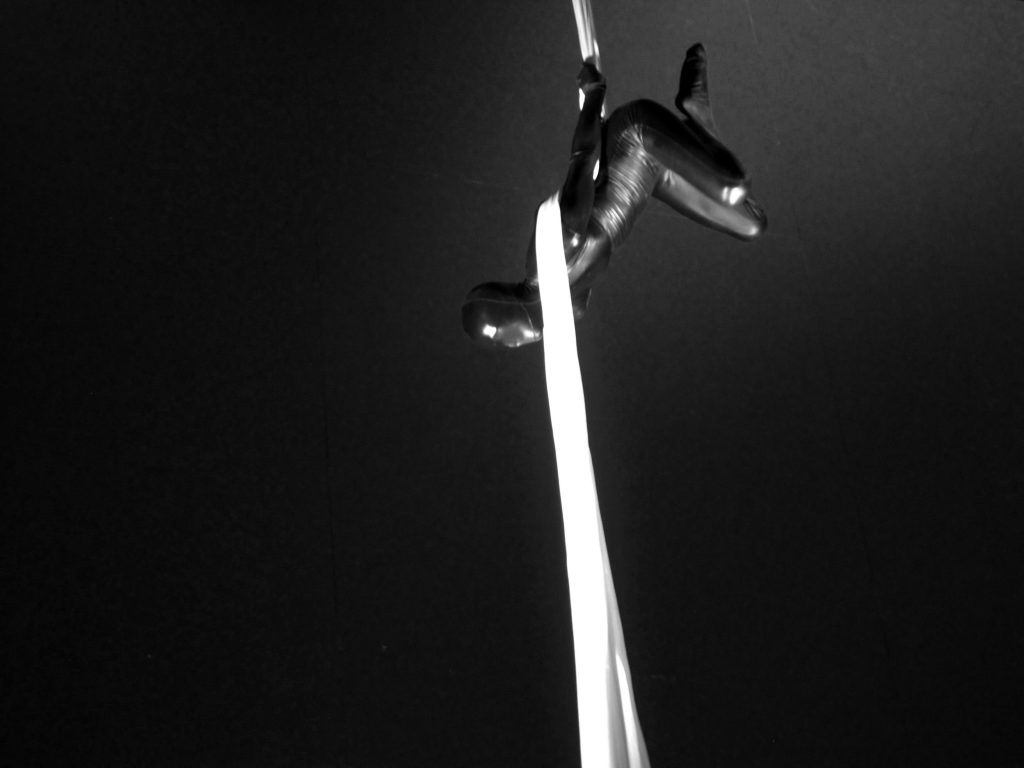
奧斯瓦多.馬西亞
16釐米電影,環繞音效轉至DVD,6分鐘,2010
《平衡》這部作品一開始是紀錄田野的聲音,完完全全只有白蝙蝠的聲音。白蝙蝠又稱「南美白折尾蝠」或「白靈蝠」。蝙蝠運用回音定位的能力辨識出自己所在的環境,在黑暗中釋出超音波利用周遭反彈的回音傳回耳內找到平衡。
在《平衡》這部電影中這種稀有的蝙蝠聲安插了進來,運用與古希臘詩同樣的韻律,以十一音節的結構成了一首旋律,並由賣藝的里歐.賀德曼詮釋。黑白電影裡賀德曼做著老套的繩索把戲,測試著平衡的極限。
這部電影伴隨一系列的草圖、照片、物化的馬西亞,於搜尋平衡概念的時候,產生並且發展,範圍從鋼筆畫到黏土模型、影片停格和哲學典故。
展示於:
羅伯特.馬普爾桑普:《夜晚的工作( Night Work )》倫敦愛利森雅客畫廊,2011年。
奧斯馬爾多.馬西亞:平衡 (個展),西班牙巴倫西亞的依斯帕維索。
《做…的白日夢》,Haunch of Venison 藝廊,於倫敦,2010年。
Equilibrium
Oswaldo Macia
six-minute 16mm film with surround sound transferred to DVD,2010
“Equilibrium”work starts with a field recording of the completely white bats, known as the ‘Northern Ghost Bat’ or ‘Diclidurus Albus’. Bats employ a system of ‘echolocation’ to create a perceptual understanding of their environment, finding their balance in darkness by emitting ultrasonic sounds that echo around their surroundings, then back to their ear muscles.
In “Equilibrium”, the sounds of these rare bats are arranged, using the same eleven-syllable structure that forms the meter in Ancient Greek lyric poetry, into a composition that is then interpreted by the acrobat Leo Hedman. The black and white film shows Hedman performing a rope-routine, testing the limits of balance.
The film is accompanied by a series of sketches, photographs and material Maciá has produced and developed while researching the concepts of equilibrium, ranging from ink drawings to plasticine models, film stills and philosophical references.
Presented at:
‘Robert Mapplethorpe: Night Work’, Alison Jacques Gallery, London, 2011
‘Oswaldo Maciá: Equilibrium’ (solo exhibition), Espaivisor, Valencia, Spain, 2010
‘daydreaming with…’, Haunch of Venison, London, 2010
﹉﹉﹉
ꕥ 作品介紹 3
妮克絲 NYX


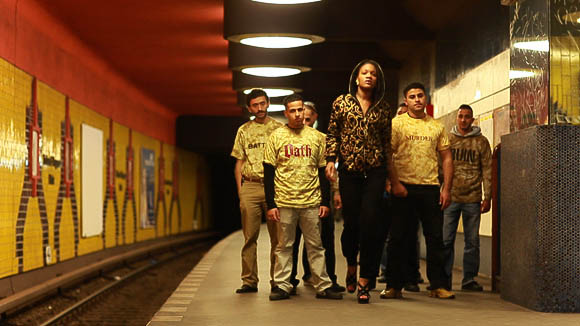
夜之女神—倪克斯
克萊兒.霍普
HD Video, 22分鐘, 2010
希臘神話裡,大地之母蓋亞(Gaia)給了我們城市的地形,夜之女神倪克斯則給了我們內在領域。倪克斯的後代是一群非常有能力的神,讓人類經驗具體化,包括了老年、憤怒、爭吵和友誼。塔納托斯是寧靜死神,他的雙胞胎兄弟許普諾斯和其老婆—幻覺女神帕西緹亞讓一位年輕人開啓了他的奧底西斯之旅,從克羅伊茨貝格(Kreuzberg)沿著第七號地鐵線到斯潘道(Spandau)。
演員陣容是由朋友及認識的人所組成,大部份都是庫德人,口述對近來的柏林歷史有著相似的經驗。克羅伊茨貝格現在有一半都是住來自世界各地的年輕藝術家和開創時尚之人。七〇和八〇年代是庫德移民的天堂時期。土耳其人、阿拉伯人和波斯人就緊鄰圍牆—德國柏林人努力想遺忘的牆—旁居住。第七號地鐵線是由建築師Rainer Rümmler在冷戰時為柏林交通管理部門(BVG)所設計,沿著斯柏利河(Spree River)還有地底牆的形狀所設計。在夜之女神—倪克斯裡,第七號地鐵線成了忘川—遺忘之河。英雄名叫福拉特,是聖河幼發拉底河的阿拉伯文。
福拉特在派對上喝醉之後睡在火車上,發現自己身在西柏林各處,直接面對或是受到夜之女神孩子們的蠱惑。帕西緹亞讓他看見幻覺,使其危險地懸處在睡眠和死亡之間。他遇見了睡神許普諾斯的兒子和「作夢的人」的靈魂—夢神摩耳甫斯,他是一些種類的傳神諭之人,幻形化身為自己母親的模樣,母親總提醒他不可以違反黑夜。前伊斯蘭教的傳統遍佈全波斯,認為有七種面向存在,而夜晚次於白晝。晚上的時候可能會遇到夜晚的惡魔(Djinn),類似古希臘惡魔或靈魂,是情緒的化身,夜晚的孩子。 福拉特的夢裡,這些全都化成一個同樣的化身。他不幸「誤闖」了夜晚的領域,得要他獻上某種祭品,而他在佩嘉蒙博物館(Pergamon Museum)的佩嘉蒙祭壇(Pergamon Altar)裡不經意找到這樣祭品。
影片的劇情是根據我從不同朋友那裡聽來的庫德人生活在柏林和土耳其的野史,尤其是從Garip Ozdem那聽到的。他非常好心讓我用從庫德斯坦的祭品羊的額外畫面。
影片的風格是受到超級英雄電影和音樂影片還有野史中簡潔且誇張的形式的影響。這種形式一起將敘事性帶出來,用碧兒崔斯Beatrice Dillon寫的音符更為冷靜地附和。Beatrice從預錄聲音到電子樣本,創作全部的內容。在古神話參考來源衝突之中,在Rummlers七〇年代平台的美學背景裡,堅持當代的節奏在故事序數的時間性裡創造出戲劇性的現在。
NYX
Claire Hooper
HD Video, 22 Minutes, 2010
Where in Greek mythology, the earth mother Gaia gives us the topos of the city, Nyx the goddess of the Night gives us the inner realm. The progeny of Nyx, a potent crowd embodying human experience include old age, rage, strife, and friendship. Thanatos, the god of quiet death, his twin Hypnos and his wife Pasithea, the goddess of hallucination, begin the Odyssian journey of a young man from Kreuzberg along the U7 line to Spandau.
The cast are made up of friends and acquaintances, mainly Kurdish, who have a parallel, if unwritten, experience of the recent history of Berlin. Kreuzberg, now semi populated with young artists and trendsetters from around the world, in the 1970s and 80s was a haven for Kurdish immigrants. The Turkish, Arab and Persian population lived in the areas directly alongside the Wall that the German Berliners wanted to forget as much as possible. U7 line, designed by Rainer Rümmler, architectural engineer for the BVG during the cold war, follows the river Spree, and the shape of the wall underground – in Nyx the U7 becomes the river Lethe, the river of forgetfulness. The hero’s name is Furat, the Arab form of Euphetes, the holy river.
Furat sleeps on the train, intoxicated after a party and finds himself in various parts of west Berlin in direct confrontation with, or under the spell of, various children of The Night. Pasithea gives him these visions, and he hangs dangerously between sleep and death. He meets Morpheus, the son of hypnos and spirit of ‘people in dreams’, an oracle of sorts, a shape shifter in the guise of his own mother, who reminds him that transgressing the night is not allowed. Pre-islamic tradition all over Persia has it that there are 7 dimensions of existence, of which the night is the second after the day. In the night one can expect to encounter the Djinn of the night, who are very similar to the Ancient Greek daemons or spirits, personifications of emotion that are the children of the night. In Furat’s dream these become one and the same. His ‘transgression’ unblessed into the realm of the night requires some form of sacrifice, which he finds unwittingly at the Pergamon Altar in the Pergamon Museum.
The plot of the film is based on anecdotes of Kurdish life in Berlin and Turkey from various friends, especially from Garip Özdem, who also kindly allowed the use of the additional scenes from Kurdistan of the goat sacrifice.
Stylistically the film is influenced by superhero movies and music videos as much as by the brevity and exaggeration of the anecdotal form. This form, which brings together the narrative, is echoed more cooly in the musical score written by Beatrice Dillon, created entirely from pre recorded sounds and electronic samples. In the midst of the clashing references to ancient mythology and within the aesthetic context of Rummlers 1970’s platforms, the insistence on the contemporaneity of the beat creates a dramatic now in which the story is told. Where a voicover stands in perhaps for Furat’s out of body observations, the music expresses his sensation, his experience, and this is the voice of NYX.
Artist Statement downloaded from Clairehooper.co.uk
﹉﹉﹉
ꕥ 作品介紹 4
精神分裂者 Schizo
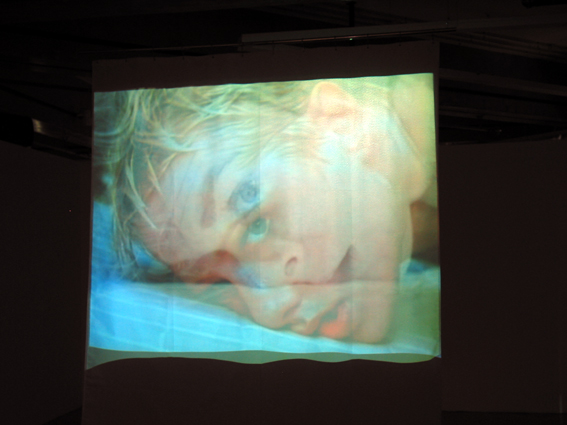
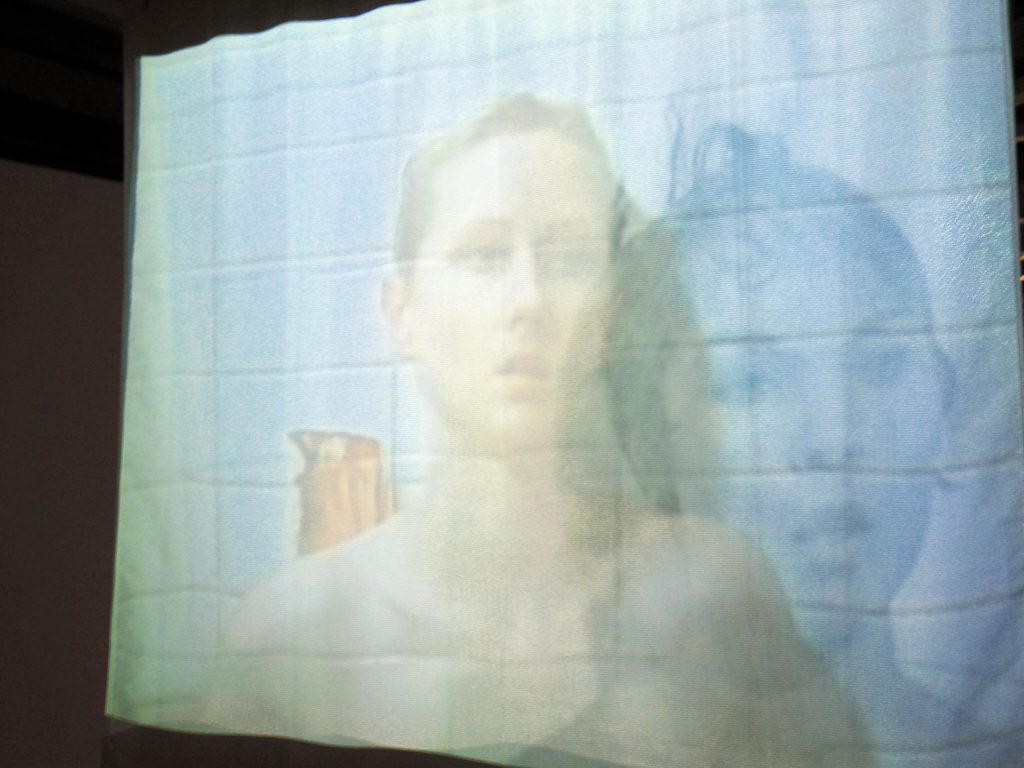
克里斯多夫.椎格
同步雙聲道錄像裝置,67分鐘 ,2001
1996年由葛斯范桑重新拍攝的驚魂記( Psycho, 彩色),忠實地呈現希區考克在1960年執導的同名黑白作品,而椎格的Schizo Redux,將這兩部片推向另一個新的高峰,他重製影片,利用剪輯對剪輯,畫面對畫面的方式,讓兩部電影的場景幾乎行進一致,最後,他再利用數位合成的技術,把這兩部電影融合,創造出一部新的電影,在他的Schizo Redux當中,所有的影像以雙重視野呈現,而希區考克驚魂記的原音在左邊的音響,右邊的聲音則是葛斯重製的電影,就好像同一時間看同一部電影兩次一樣,而驚魂記就變成了精神分裂者,影片中的每個人物,都好像有一個長相打扮相近的代言人、每句台詞好像都是卡農二部曲(canon)、而人物說話時,好像都有回音似的,當觀賞者適應了這種奇怪的現象,他的大腦就能把這部作品看做是一部新片,這種讓人很不舒服的效果,事實上可以引發出真正幻覺般的感受,甚至可以讓觀賞者真的產生精神分裂的體驗。
Schizo
Christoph Draeger
Synchronized two channel video installation, 67 mins, 2001
Gus Van Sant’s remake Psycho (1996, color) of Alfred Hitchcock’s Psycho (1960, b&w) is the most exact reconstruction of a movie in the history of cinema. Christoph Draeger’s Schizo Redux synchronizes these two films even further: They were re-edited cut by cut, frame by frame in a way so each take in both movies became almost exactly synchronized. Finally, by digitally dissolving the two films into one another, Draeger created a new film, in which all images appear as double visions. The soundtrack of the original is on the left, the remake on the right of the stereo spectrum. It’s like seeing the (almost) same movie twice at the same moment: Psycho becomes Schizo. Every protagonist has a doppelganger, every line is spoken in canon, or else carries an echo. As the viewer’s perception is getting used to this distortion, his brain starts to accept the new film as one: a deeply troubling effect that can trigger a truly psychedelic, or better, schizophrenic experience.
﹉﹉﹉
ꕥ 作品介紹 5
在蛆蟲的影子之下 Im Schatten der Made
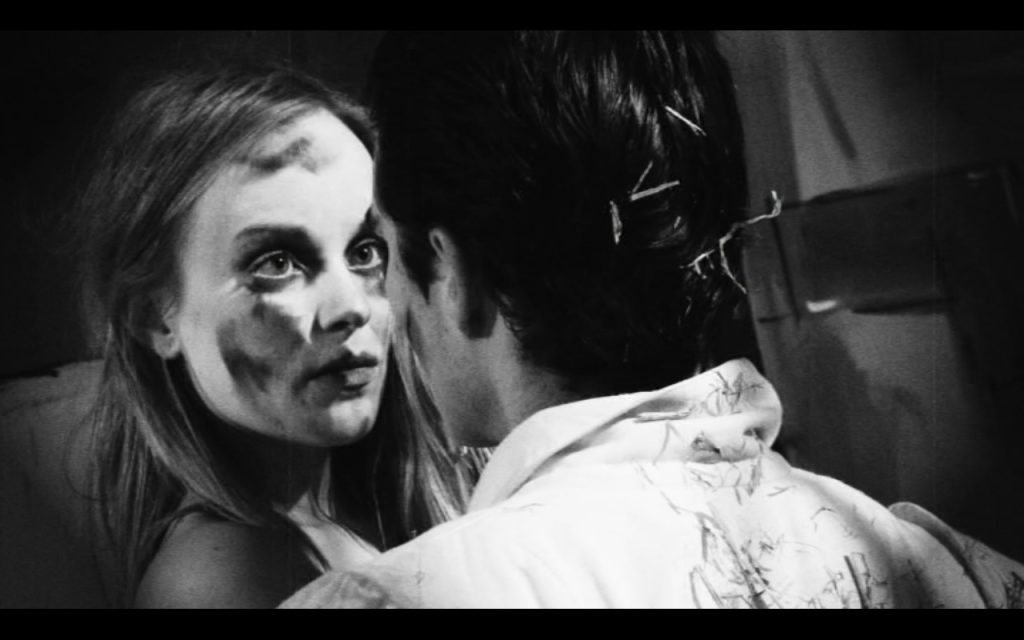
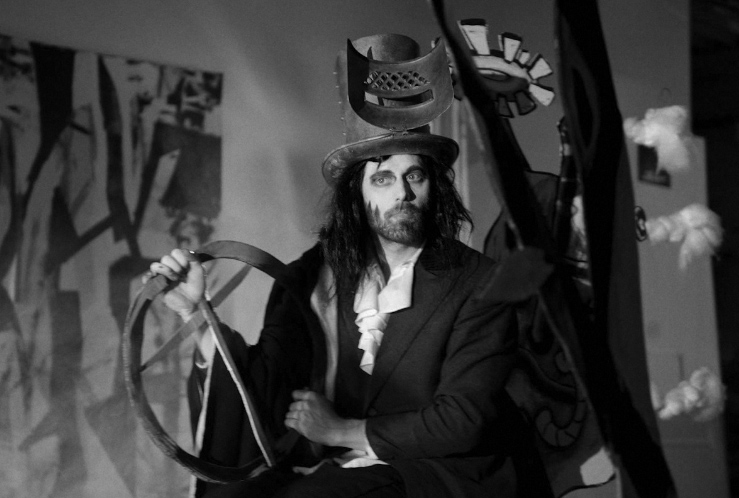
約翰.博客
黑白高清影片,74 分鐘,2010
錄像裝置的作品帶著人與機械之間某種心繫的關係。像這樣的數位黑白攝影令人回想起1920年代的戲院,以及早期電影如「科學怪人」、「卡里加利博士」、「大都會」等。
這作品以約翰博客典型的新表現主義達達風格來敘述,描寫一位瘋狂的科學家,創造了一個人類機器人,而這個新造的生物吸引了這瘋狂科學家妻子的愛戀。
這是一個關於接納、偏見、相異性、愛、錯待以及揭露的故事。猶如默片一樣沒有聲音,只有一個潛伏的配樂存在著。
該影片是整個裝置作品裡的一小部分-在玻璃櫃中展示著電影的殘跡,例如西裝、頭、景觀模型等等。
Im Schatten der Made
John Bock
HD black & white video, 74 mins, 2010
Video installation works has its heart relationship of man and machine. It is shot digitally in black and white reminiscent of early cinema from the 1920’s and like the early films, such as Frankenstein, Dr. Caligari or Metropolis.
It tells in the signature Neo-dada John Bock style, the story of a mad scientist, who creates an artificial android human. This new-born creature attracts the loving attention of the wife of the mad scientist.
It is a story of acceptance, prejudice, otherness, love and abuse unfolds – told like a silent film without sound but an underlying musical score. The film is part of an installation – showing in vitrines remnants of the film, like suits, heads, model scenery and more.
﹉﹉﹉
ꕥ 作品介紹 6
在更深處 In Deeper
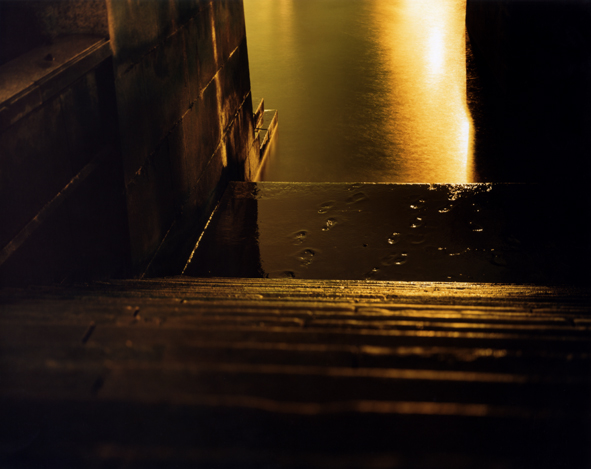
盧.布莉絲.盧森堡
顯色彩色印刷,鋁板,65 x 75 cm,1999
掌控河流的潮汐消退,讓往倫敦泰晤士河的階梯顯露出來,每天有兩次機會看到。在泥淖中消退的階梯到了邊緣又返回,因此不是自殺的意象。河流和潮汐的規律印證了城市的本性。這個作品的標題是從羅蘭.巴特(Roland Barthes)的格言:「要出來,先往更深處走(To get out, go in deeper)」來的。作品評論攝影的性質和其潛力,讓一切顯露可見,讓人看見隱藏或是遺漏的部份。
In Deeper (Nach Innen)
from the series: Liebeslied
Rut Blees Luxemburg
C-Print on Aluminium, 65 x 75 cm, 1999
The steps leading to the river Thames in London are visible twice a day when the tides, that govern the flow of the river, reveal them. The traces of footsteps receeding in the mud go to the edge and then return, hence it is not the image of a suicide. The river and its tidal laws affirm the presence of nature in the city. The work’s title is taken from Roland Barthes’s dictum ‘To get out, go in deeper’. The work comments on the nature of photography and its potential to make visible and to bring to the light that which is concealed or overlooked.
﹉﹉﹉
ꕥ 作品介紹 7
火燒摩天樓 Towering Inferno
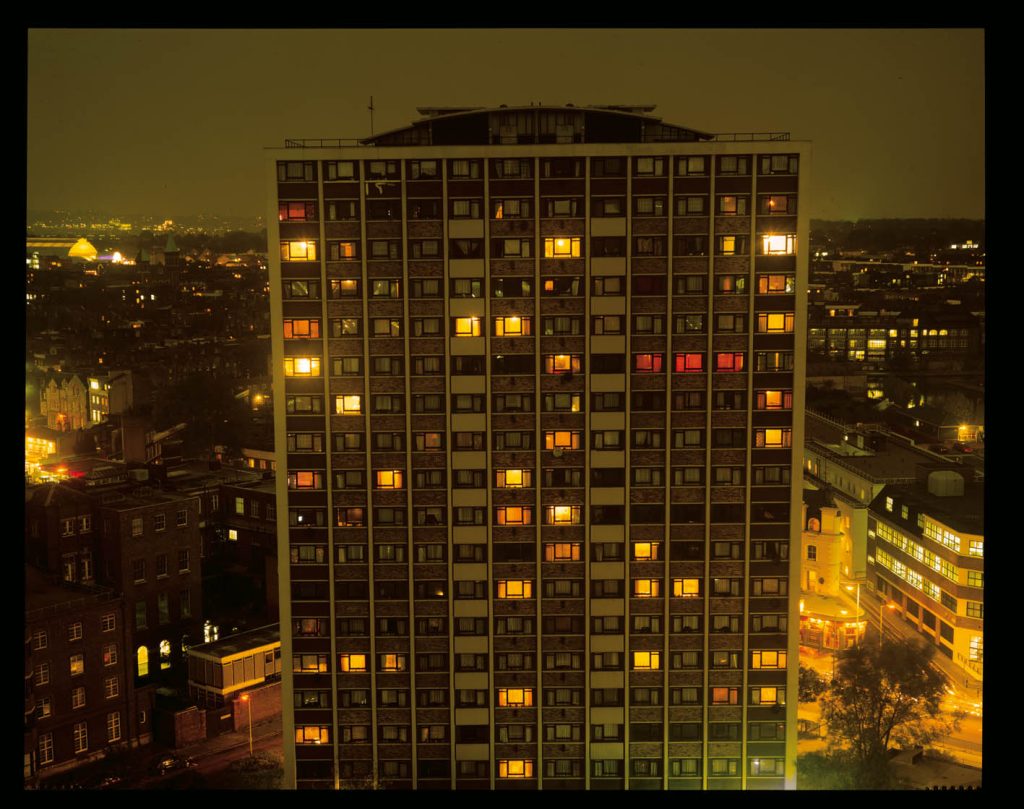
選自系列:倫敦—現代工程計畫案
盧.布莉絲.盧森堡
顯色彩色印刷,鋁板,70 x 80 cm,1999
倫敦東區的高樓閃耀著繁忙,這種建築形式被沒見識的人視為英國社會烏托邦的殘忍敗筆,卻是我早期作品的焦點,因為這種建築有俯瞰城市的好視野,也表述現代工程和高樓的野心。
Towering Inferno,
from the series: London – A Modern Project
Rut Blees Luxemburg
C-Print on Aluminium, 70 x 80 cm, 1999
The tall high-rise in the East-end of London is a glowing hive of activity. This architectural form, rashly rejected as the brutalist failure of a social utopia in Britain, became the focus of my early works, as it provides a vantage point to vision the city and to address the modern project and its ambitions.
﹉﹉﹉
ꕥ 作品介紹 8
穿越硫磺霧氣我們再度無所畏懼
Piercing Through the Sulfur Fumes We Are All Feeling Audacious Again
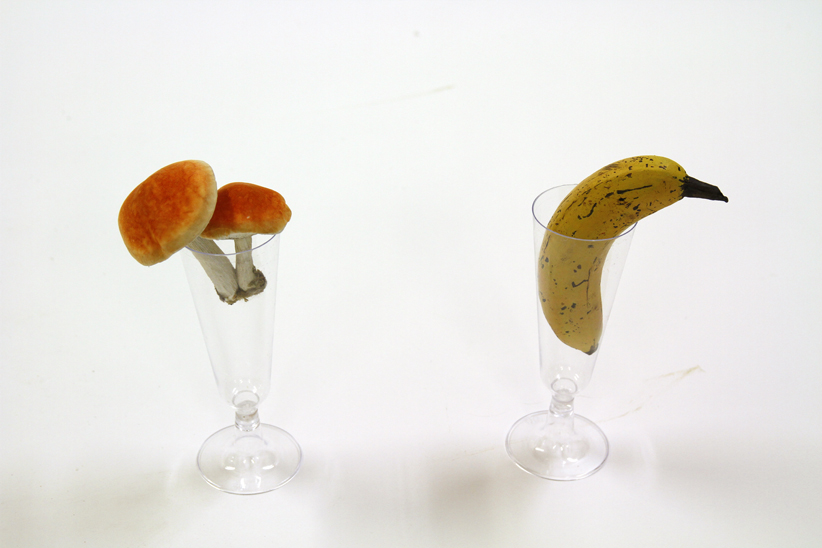
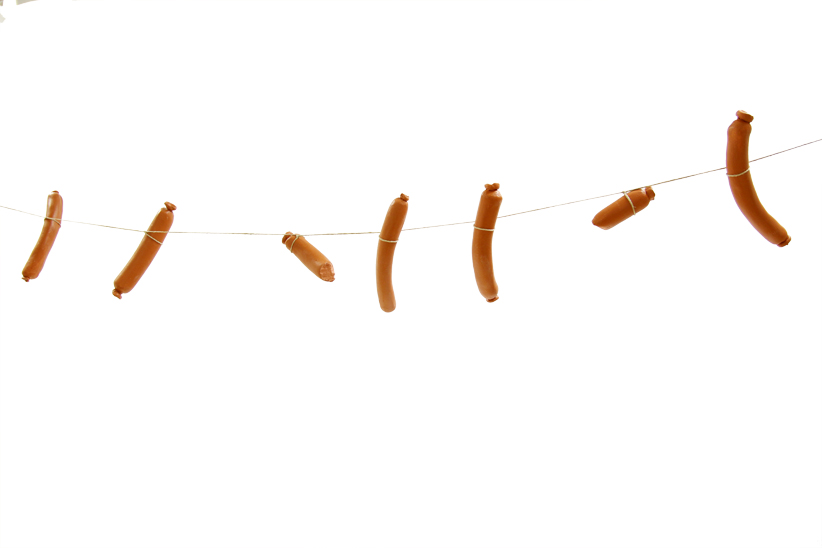
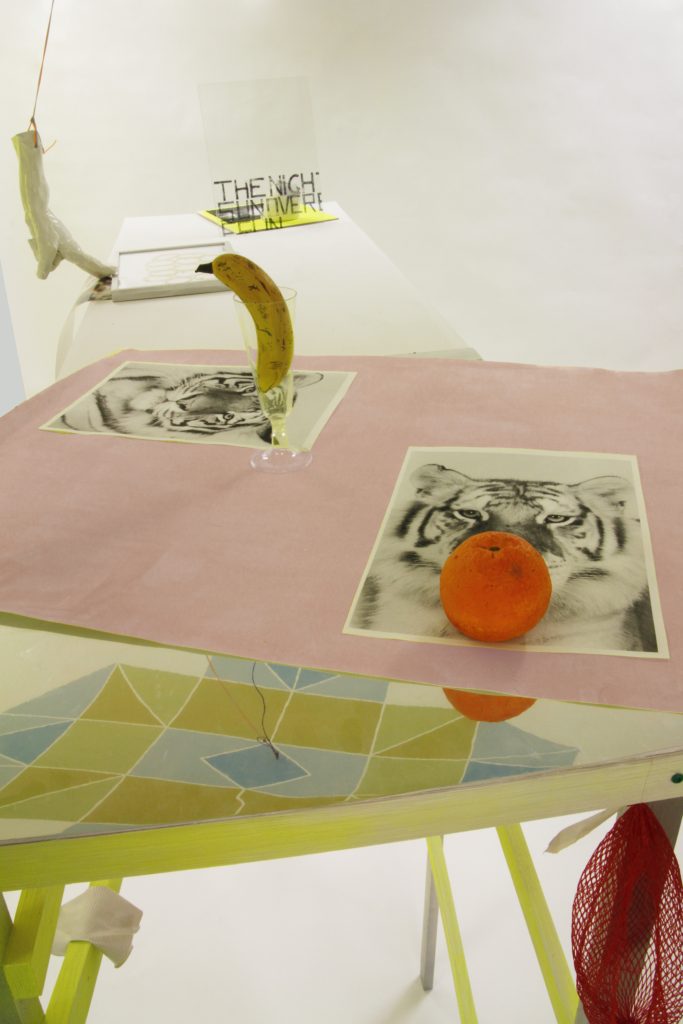
馬地伊山.布藍德
石膏、粘土、噴漆、3D圖像,2011
我為台北數位藝術中心(DAC)所創作的作品《穿越硫磺霧氣我們再度無所畏懼》是由許多元素之間的對話及互動所組成,並且由各種設計,歷史,新生代文化和我周圍的環境擷取其原始材料。
我們的目的在於結合並發揮作品的元素,以達成意想不到的連結。這些不同的物體、意象、圖案和形狀,代表著抽象和互相衝擊的情境、觀點與徵象。 副屬結構體的裝飾和設計則與新生代文化趨勢和裝潢設計相關聯,並且概括不同種類的物件,包括石膏、粘土、噴漆和3D圖像。
在我架構為台北數位藝術中心的作品取向,採去的態度是輕鬆的、直覺的。這樣的觀點,成為我嘗試婉轉的正式化作品的視覺語言要素。有時這會變得複雜或如象形文字一般,卻也提供了詮釋和意念的空隙。在主題作品旁,有一組懸吊、糾纏著的物品和植物,一個簡易動能的穿插,以及一個壁畫,並以零散片段的方式,套用了我柏林工作室中的空間元素 — 這是由一個原先作為BVG (柏林運輸公司)員工盥洗室所改裝的—我的工作室十分普通, 就是瓷磚地板和牆壁,然而這些卻以令人意外的青翠色彩,於這個地點、這個用途的地方,造就了藍綠色調的抽象圖案。
我工作室的主題,和至展覽場的轉移並未完全實踐,只是稍稍意味了: 創造一個開放以及實驗氛圍的空間,隱喻著創作成形過程的心理空間。有許許多多的事情發生,一個想法的渦輪、形式、物件、影像紛飛並拼湊著繽紛圍繞的抽象套譜。
Piercing Through the Sulfur Fumes We Are All Feeling Audacious Again
Matti Isan Blind
Casts, clays, graffiti and 3D images,2011
For the DAC Taipei I developed the work ‘Piercing through the sulfur fumes we are all feeling audacious again’, which is made up of various elements communicating and interacting with each other drawing its resources from design, history, youth culture and my immediate surroundings.
The intention is to combine and to play off the elements of the work, to make unexpected connections. The various objects, images, patterns and shapes refer to situations, observations and signs which are abstracted and clashing with each other. The support structures are ornamented and designed relating to tendencies in youth culture and furniture design and hosts a variety of objects including casts and clays, graffiti and 3D images.
My approach in developing the works for DAC Taipei is to be light-hearted and intuitive in my attempt to zigzag, to play with my formal vocabulary, which at times can become complex and hieroglyphic, opening gaps of opportunities for interpretation and intention. Alongside the main work are a number of others, a dangling entangled collection of objects, plants, a low tech kinetic intervention and a wall drawing, which in a fragmentary manner picks up elements of my studio space in Berlin – housed in one of the former washrooms for the workers of the BVG (Berlin Transport Company) – my studio is anything but neutral, made up of tiled floors and walls, which are cut in an unexpectedly lush way for such a location and purpose, featuring abstract patterns in hues of green and blue.
The theme of the studio and its transferal to the exhibition space is not implemented fully but only alluded to – creating a sense of openness and experimentation, a metaphor for the mental space where creative processes take shape. A lot is going on, a whirlpool of thought, forms, objects and images swirling and shaping a polychromatic arrangement of abstraction.
ꕥ 相關活動
開幕茶會opening
2011.5.07(Sat.)14:00
藝術家座談 Artist Talk
2011.5.07(Sat.)16:00-17:00
藝術家Artist:盧.布莉絲.盧森堡(Rut Blees Luxemburg)
音樂會Concert
2011.5.07(Sat.)17:30-18:30
DJ:Chez
 EXHIBITION
EXHIBITION
